24 Km for Paris 2024 Olympics Games 2017 Edition
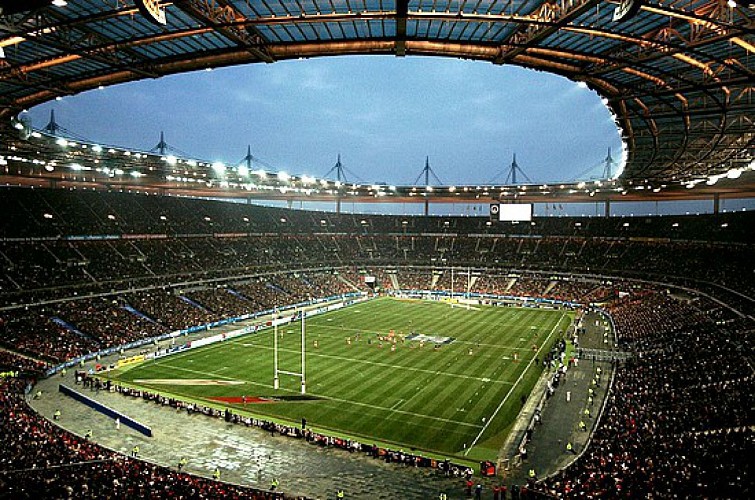
Description
The 24 km for 2024 Olympics Games support the candidacy of Paris for the organization of the Olympic and Paralympic Games, This walking is also cultural. By joining the places where different disciplines will take place, you will discover the architectural and environmental heritage of "Seine Saint Denis".
Everyone can select a distance 9.5 Km; 15.5 Km; 18 km or 24 km.
Technical informations
27 km
|
max. 57 m
min. 28 m
51 m
| |||
Accessibility | ||||
Style : Discovery Public : Occasional hikersExperienced hikers Theme : Cultural | ||||
Altimetric profile
Starting point
Steps
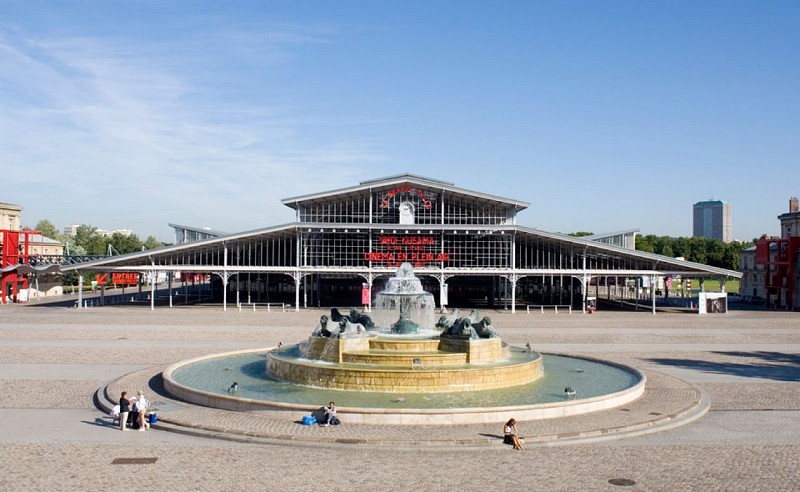
From Vilette's Grande Halle
Start from the "Grande Halle de la Villette", follow the Ourcq Canal to Pantin, take the Delizy street then General Leclerc's avenue while passing in front of the swimming pool of Pantin.

Return to the Parc de la Villette by the other river bank.
Join the Canal de l'Ourcq to return to the "Parc de la Villette", on the other side,to the basin of "La Villette". On the right follow the canal of Saint Denis, you will walk on the "Street Art Avenue" of "Seine Saint Deni"s. Continue until you cross the railways.

Go towards the Saint Ouen City Hall.
After crossing the SNCF line, take the "Francis de Pressense" street on the left and then the François Mitterrand avenue. On the left is "rue des cheminots", on the right the "rue du Landy", on the left Michelet avenue, then Émile Cordon street will lead you to the Saint Ouen city hall.
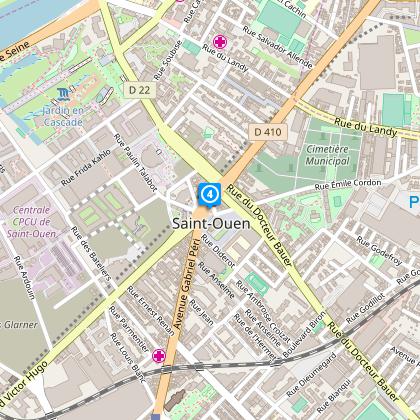
Saint-Ouen castle
From the city hall Albert Dhalenne street will lead you to the Saint-Ouen Castle..

To Pleyel Tower
Follow Saint-Denis street, in the old Saint Ouen, pass the church. In the rue Ampère, on the left, will be built the Olympic Village. Pass in front of the Cité du Cinéma then by the alley of Seine join Pleyel Tower.
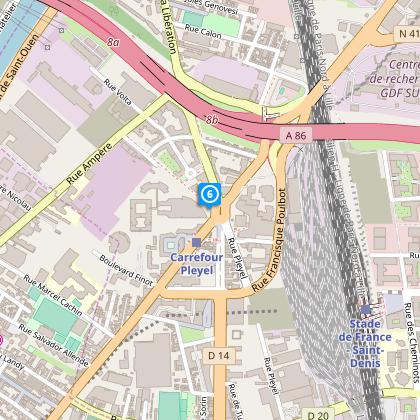
Stade de France and honor legion square
From Pleyel Tower go towards the Stade de France by following the markings, watch out for protected passages. Pass on the Ellipse mall in front of the Stade de France, take the bridge and head towards the Parc de la Legion d'Honneur.
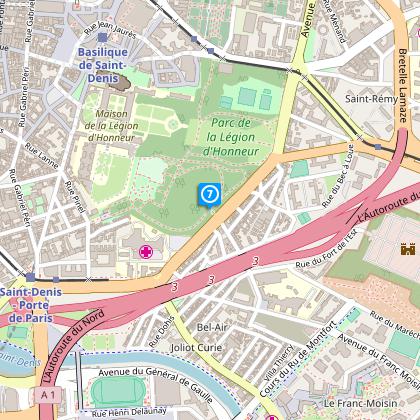
Go to the Basilica Saint-Denis
Enter in the Honor Legion Square, follow on the left, go out the parc. Go on to the Basilica.
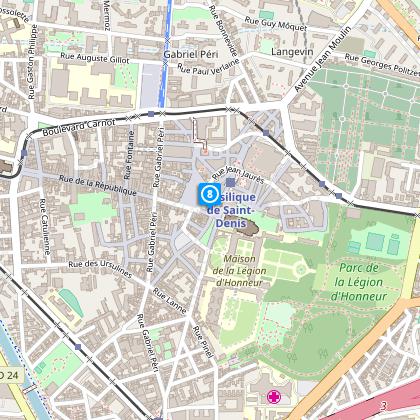
To Georges Valbon Park
Walk along the basilica to the left, join the Strasbourg street, left Lenin Avenue, turn right on the aisles to Jacques Vache Street and Avenue Romain Rolland. Enter the Marville Sports Park (WC in the park). Cross and leave the park to enter the Georges Valbon Park through the entrance Montjoie. Take the alley on the left towards the rose garden.
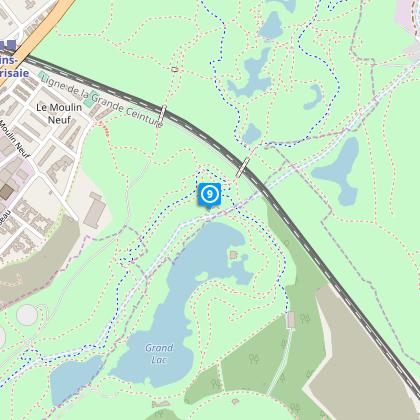
Dugny
Cross the bridge of Iris, turn right then left to exit the park through the entrance of Poiriers, pass in Dugny, join the park through the entrance Thorez taking Salengro street.
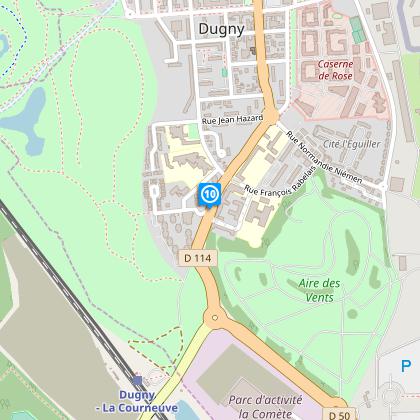
To the "Tapis Vert"
From the Thorez entrance, go back over the Iris Bridge, then bypassing the lake on the left, join the lawn of the Tapis Vert.
Points of interest
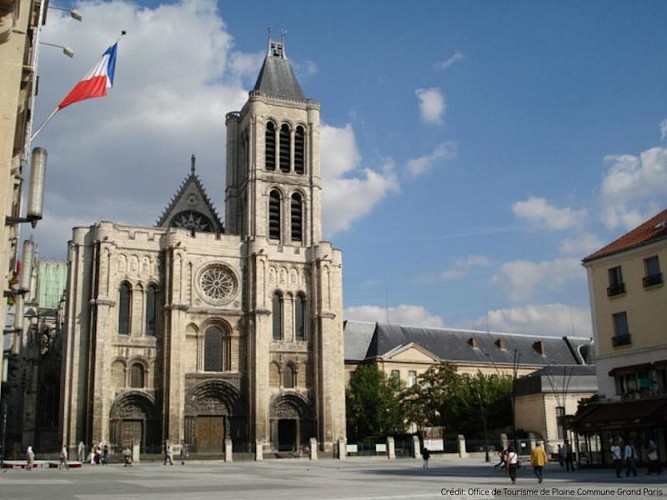
Basilica Saint-Denis
The Basilica of Saint Denis (French: Basilique royale de Saint-Denis, or simply Basilique Saint-Denis) is a large medieval abbey church in the city of Saint-Denis, now a northern suburb of Paris. The building is of unique importance historically and architecturally as its choir, completed in 1144, shows the first use of all of the elements of Gothic architecture. The site originated as a Gallo-Roman cemetery in late Roman times. The archeological remains still lie beneath the cathedral; the people buried there seem to have had a faith that was a mix of Christian and pre-Christian beliefs and practices.Around 475 St. Genevieve purchased some land and built Saint-Denys de la Chapelle. In 636 on the orders of Dagobert I the relics of Saint Denis, a patron saint of France, were reinterred in the basilica. The relics of St-Denis, which had been transferred to the parish church of the town in 1795, were brought back again to the abbey in 1819. The basilica became a place of pilgrimage and the burial place of the French Kings with nearly every king from the 10th to the 18th centuries being buried there, as well as many from previous centuries. (It was not used for the coronations of kings, that function being reserved for the Cathedral of Reims; however, French Queens were commonly crowned there.) "Saint-Denis" soon became the abbey church of a growing monastic complex. In the 12th century the Abbot Suger rebuilt portions of the abbey church using innovative structural and decorative features. In doing so, he is said to have created the first truly Gothic building.[3] The basilica's 13th-century nave is the prototype for the Rayonnant Gothic style, and provided an architectural model for many medieval cathedrals and abbeys of northern France, Germany, England and a great many other countries. The abbey church became a cathedral in 1966 and is the seat of the Bishop of Saint-Denis. Although known as the "Basilica of St Denis", the cathedral has not been granted the title of Minor Basilica by the Vatican. From : en.wikipedia.org/wiki/basilica_of_st_denis
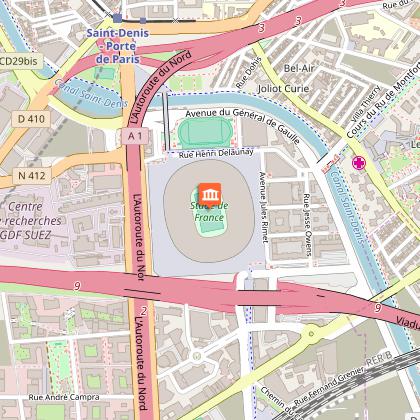
Stade De France
The Stade de France (French pronunciation: [stad də fʁɑ̃s]) is the national stadium of France, located just north of Paris in the commune of Saint-Denis. Its seating capacity of 81,338 makes it the sixth-largest stadium in Europe. The stadium is used by the France national football team and French rugby union team for international competition. The Stadium is also the tenth-largest stadium in the world, and the largest in Europe for track and field events, seating 78,338 in that configuration. Despite that, the stadium's running track is mostly hidden under the football pitch, as no major track events have been held there regularly since 2017, when Meeting de Paris returned to Stade Sébastien Charléty after 19 years. The European Athletics Championships will be held there in August 2020. Originally built for the 1998 FIFA World Cup, the stadium's name was recommended by Michel Platini, head of the organising committee. On 12 July 1998, France defeated Brazil 3–0 in the 1998 FIFA World Cup Final contested at the stadium. It will host the opening and closing ceremonies and the athletics events at the 2024 Summer Olympics. Stade de France, listed as a Category 4 stadium by UEFA, hosted matches at the 1998 FIFA World Cup, the UEFA Champions League finals in 2000 and 2006, and the 1999 and 2007 Rugby World Cup, making it the only stadium in the world to have hosted both a Football World Cup final and a Rugby World Cup final. The facility also hosted the Race of Champions auto race in 2004, 2005, and 2006. The stadium hosted the 2003 World Championships in Athletics and since 1999 it has hosted the annual Meeting Areva athletics meet. It also hosted some matches at UEFA Euro 2016, including the 2016 final, where France lost to Portugal 1-0 after extra-time. Domestically, the Stade de France serves as a secondary home facility of Parisian rugby clubs Stade Français and Racing Métro 92, hosting a few of their regular-season fixtures. The stadium also hosts the main French domestic cup finals, which include the Coupe de France (both football and rugby), Coupe de la Ligue, Challenge de France, and the Coupe Gambardella, as well as the Top 14 rugby union championship match. From : en.wikipedia.org/wiki/stade_de_france
Additional information
Access to the course
Access to the course are proposed according to the desired distance:
1) 24 Km Departure from the "Grande Halle de la Villette" subway station "Porte de Pantin" , Line 5.
2) 18 Km Start from the point 3: Use RER B or D - station "La Plaine Stade de France"
3) 15 Km Start from the point 4: subway station "Mairie de Saint-Ouen", line 13
4) 9.5 Km Start from the point 8: subway station "Saint Denis Basilique" , line 13 or use tramway T1 - station "Saint Denis Basilique"
Do not forget: On each point, the function "join the POI" use Googles Maps to guide you to the starting point.
Data author

The Cirkwi brief
The 24 Km for 2024 journey is not just a walk; it's an immersive experience that champions Paris's bid for the Olympic and Paralympic Games while unveiling the architectural and environmental heritage of Seine Saint Denis. Offered by the FFRandonnee Seine-Saint-Denis, this adventure allows participants to select from distances ranging from 9.5 Km to 24 Km, making it accessible to everyone. Capturing the spirit of the Olympics, the walk guides you through historical landmarks, including the iconic Basilique Saint-Denis, blending physical activity with cultural exploration in a unique celebration of both Paris's past and its future Olympic dreams.
Key Route Details Unveiled
Spanning approximately 26.9 kilometers, this meticulously plotted route peaks at an altitude of 57 meters, with the lowest point sitting at 28 meters above sea level. Elevations oscillate, presenting a moderate cumulative positive elevation change between 51 to 67 meters throughout the journey. Structured by the FFRandonnee Seine-Saint-Denis, it's a path that challenges and rewards, striking a balance between accessibility for the casual walker and engagement for the more seasoned hiker.
Seasonal Tips for Every Traveler
No matter the season, preparing for the 24 Km journey demands a few considerations. Spring and autumn offer mild temperatures and vibrant scenery, making them ideal for walking. However, be ready for rain by packing waterproof gear. Summers can be warm, so early morning starts are advisable to beat the heat, along with carrying sunscreen and ample water. Winters, though colder, provide a crisp atmosphere; layering clothing for warmth while ensuring good footwear for potentially slippery paths is crucial. Safety-wise, always inform someone of your route details before you embark.
Seine Saint Denis: Heart of Heritage
Seine Saint Denis, with its center stage as the destination for the 24 Km journey, is a vibrant tapestry of cultural and historical significance, especially notable for sites like the Basilique Saint-Denis. This region, blending a rich past with a dynamically evolving present, offers a profound narrative about France's royal history and a peek into the country's future as a potential Olympic host. The area serves as a testament to France’s architectural mastery and its longstanding tradition of commemorating heroes and historical events through monuments, making it an invaluable educational resource for both locals and visitors.
Climate Guide for Optimal Visiting
The climate in the Parisian area, including Seine Saint Denis, is predominantly oceanic, with mild to moderately warm summers and cold winters. Rainfall is distributed fairly throughout the year, implying that there's no distinctly wrong time to undertake the 24 Km for 2024 route. However, for the most pleasant experience, aim for late spring (May to June) or early autumn (September to October). These periods typically offer temperate weather, less crowded pathways, and the natural beauty of the region in gentle transition, providing an optimal backdrop for this cultural and historical exploration.